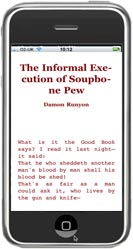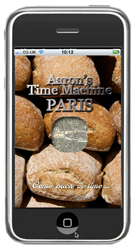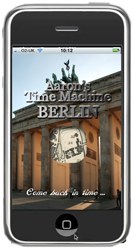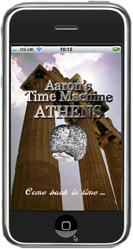Where does iPad fit in a 3 Screens world?
January 28th, 2010by Gwyn Headley
Managing Director
Tags: Apple, ebook, iPad, iphone, iPod Touch, Kindle, three screens
This morning The Times, The Telegraph and The Independent all had front page solus photographs of Steve Jobs holding up the new iPad. If only fotoLibra could have just one day’s worth a year of the publicity Apple gets!
iPad is a much better name than iSlate. Whoever thought iSlate would win out?
So Apple’s latest gottahave has finally been released. It’s as lovely as anticipated and it does several of the things that were expected. No phone, no camera, not even a little one buried in the frame looking at you so you can do video conferencing. Not needed because there’s no phone. But I suppose as it’s an internet browser it can Skype, so it could be used as a phone?
Of course I want one, and I want it now.
But what will I do with it? What basic need does it fulfil?
Most of us in the sedentary Western world live a three screens life — mobile, laptop, TV. When I’m not reading, I’m usually to be found staring at one of these objects. What I’m not so certain about is how much I hanker after a four screens life.
Which was always a good argument against Amazon’s Kindle, that clunky black and white book sales outlet. The new iPad blows the Kindle out of the water. It is incomparably more desirable. Put the two together and they look as if they’ve come from different centuries (which they probably have). Of course the iPad’s bookstore feature only works in the US, as Kindle’s did until very recently.
When all the brouhaha and hyperbole have been swept away, what have we got with the iPad? It’s a big screen iPod Touch with some software packages thrown in. It’s a big iPhone — without the phone.
I can live without it. For now.
But when Version 2.0 comes out …
Kindle for the iPhone
January 13th, 2010Amazon announced a Kindle app for the iPhone a while ago; I’ve just got round to downloading it.
Now I’m a fan of ebooks. It’s a great concept, and therein lies the future — but I still have reservations. I don’t think there will be a tipping point from print to ebooks any time soon.
It won’t happen as quickly as many gurus hope it will, because
1. New ebook readers are announced daily. One format must achieve dominance, by which I mean 80%+ of the market.
2. That format has to do everything: colour, sound, movies, the lot
3. They are furiously expensive
4. We’re not there yet
Amazon famously announced that on Christmas Day more ebooks were downloaded than than they sold printed books. The future had arrived.
Well, durrr. Who is going to be on line buying books on Christmas Day? And who is more likely to be sitting in their solitary flat with the turkey pizza shoved under the door, endlessly scanning the internet for stuff to download?
Weren’t 8 out of 10 of their top selling ebooks all giveaways? How many of the print titles were free? I think we’ve been handed some spurious statistics here, and it’s been repeated all over the place.
The chatterati WANT ebooks to succeed. And of course they will. But a lot of people have got to get their acts together pretty damn quickly if it’s going to happen any time soon.
What prompted this? Well, I downloaded the Kindle app, and then I downloaded an ebook from Amazon.
And this is what I saw:

Well, I’m sorry — I gave up right away. There are graphic standards to keep to in this world, and I refuse to dumb down to
THE INFORMAL EXE-
CUTION OF SOUPBO-
NE PEW
which is beyond pathetic as any sort of commercial offering.
Keep trying, chaps. I’m sure you’ll make it eventually.
The ebooks that Neil Smith and I have produced for Aaron’s Apps are attractive, readable, innovative, colourful, non-linear, a new way of presenting a guide book, a new way of presenting history, and (though of course I’m saying all this myself) a genuinely new way of reading a book. These are guide books that follow YOU about, not the other way around. One huge illustration, eight feet by six feet, 160 pages which you can read in any order, and a nifty way to locate yourself in a city 200 years ago, as easily as today. Impossible to replicate in a printed book.
Now THAT’s what I call an ebook. The world should be beating a path to our door.







The Future of Online Advertising
January 12th, 2010by Gwyn Headley
Managing Director
The US Patent Office has just granted a patent to Ryan Hickman of Mountain View, California (read Google) for identifying features in an online view of a real property and then replacing those features.
So if you see a poster or a billboard in Google Street View, it may not actually be there — it may have been replaced by a competitor’s advertisement. When you’re on the street, you see a big Pepsi ad, but online it’s magically transformed into a Coke ad.
I can see this would be great for cinemas and theatres, being able to update the features they’re showing, but otherwise this smacks a little of Big Brother to me. It will benefit large corporations. They will elbow out smaller businesses, like Waitrose and Tesco opening up next to the perfectly good Budgens in Crouch End.
I can’t help supporting the underdog. I am one.
Here’s the text of the granted patent. Read it and work out the implications, the ramifications, the possibilities. Rub your hands if you are in corporate life and get prepared to give yet more money to Google.
It’s damned clever, though.
Claiming Real Estate in Panoramic or 3D Mapping Environments for Advertising (granted January 7, 2010)
Abstract
Techniques for identifying groups of features in an online geographic view of a real property and replacing and/or augmenting the groups of features with advertisement information are described. The techniques include providing a geographic view of a property within an online property management system, identifying a region of interest in the geographic view, analyzing the geographic view to locate one or more promotional features within the geographic view positioned upon a real property region, providing a user-selectable link associated with the region of interest in the geographic view, receiving a request for the region of interest in the geographic view via the user-selectable link, receiving data to alter at least one of the behavior or the appearance of the region of interest, storing the data in association with the geographic view, and updating the region of interest within the geographic view based upon the received data.
fotoLibra 2009 Pro Blog Index
January 7th, 2010by Gwyn Headley
Managing Director
Tags: Aaron's Apps, Aaron's Time Machine, Adobe, Amazon, Apple, BAPLA, book publishing, books, CS3, CS4, drag and drop, easy upload, ebook, ebooks, Encyclopedia of Fonts, fotoLibra, Google, heritage, iphone, iphone apps, Macintosh, marketing photographs, Microsoft, Model releases, photography, Photoshop, picture library, picture sales, Prices, property releases, rights, selling photographs, selling pictures, stock agency, territories, upload checker, user experience
Here’s an index to the fotoLibra Pro Blog for the whole of 2009.
As I complained 6 months ago, it takes a surprising amount of time to compile, so if there are any WordPress experts out there who know how to automate this process, we’d love to hear from you.
If you’re new to fotoLibra, welcome, and may we suggest you read through the HINTS & TIPS section, and if nothing else read Great Expectations. If you enjoy a bit of controversy, read BAPLA Shock Horror.
Comments are welcome, even on old posts, and will be read and often responded to.
HINTS & TIPS
- Three hundred pixels per inch
- Shots of Redemption
- How To Take Aerial Photographs When You Haven’t Got An Aeroplane
- Compression
- Great Expectations
- RSVP
ABOUT FOTOLIBRA
- New fotoLibra
- BOMBSHELL
- Most Popular Searches
- White Labelling
- A Third of a Million
- Picture Calls
- fotoLibra DND & Checker 2.1 Released
- Drag ‘n’ Drop Upload Checker
- The New Picture Call Tab
- SPQR
- Search Engines and fotoLibra
- Yahoo Blocks Our Emails
- It’s got to be today
- 300,000 up!
ADOBE
BAPLA
CUSTOMERS
E-BOOKS & PUBLISHING
- Free iPhone App: Aaron’s Time Machine: London Lyte!
- Orphan Books
- The Killer eBook Is Nearly Here
- UK Politicians Not Entranced by eBooks
- Primary School Books
- Getting ready for e-books and Graphics
- Kindle 2
- More Kindling
- The Killer Book for e-books
IT
LAW
MISCELLANY
- Winterval
- Reunited
- Prophecies & Prophets
- Unpleasant Comments & Spam
- Proto-foto-Libra
- Cancelled Air Show
- Giving It Away For Free
- A heritage in photography
- Farewell Kodachrome
- The perils of publishing
- Happy New Year
NETWORKING
NEWS
PICTURE CALLS
SECURITY
TRADE FAIRS
Happy Snow Year
January 6th, 2010by Gwyn Headley
Managing Director
Apparently this snow and cold isn’t confined to Britain. Seems like it’s snowing all over the world, except in Cape Town where that nasty Graeme Smith has been putting our plucky boys to the sword. It is glorious weather down there, 28°C, a warm breeze and cloudless skies. Yum yum. Newlands, and a bottle of Rust en Vrede to keep me company … a man can dream, can’t he?
Anyway, while it’s snowing — or, even better, when the sun comes out just after the snow, please get out there and use that camera. We always need snow shots, and cutomers usually ask us for them in May or June, so please be prepared now. As most of you know, I’m no photographer myself, but make sure you mug up on how to use that white balance control on your camera so the snow looks crisp and white.
Grey snow pictures don’t sell, except for gritty realist images of buses struggling to get up hills. We always need more grit.
Away from the winter wonderland, close observers will know that fotoLibra’s former technical development manager Neil Smith and I have been writing some iPhone apps together. Aaron’s Apps now has its own web site, so please check out http://aaronsapps.com to find out about the applications we’ve released (two) and the ones we have planned (eight at the moment).
Winterval
December 30th, 2009by Gwyn Headley
Managing Director
What a detestable neologism. But I guess there’s no other way to describe the secular gap between the Christian festival of Christmas and the astronomical (or Scottish) festival of the New Year.
I’ve never been sure why New Year doesn’t come at the time of the winter solstice, which this year was 17:47 on December 21st.
In Britain, this is traditionally the time when we skive off. Shopworkers are run off their feet, but the rest of us gaze glumly out of our windows at the steady drizzle, briefly think about taking the dog for a walk then go back and slump in front of the telly instead.
Not fotoLibra! Of course we’re hard at it all the time. At least our Snowdonia office is, judging by the Picture Call I’ve just received from Jacqui Norman. Here in London, however, we’re running a Reactive week, which means we’ll respond to you if it’s urgent (like if you want to buy pictures) but otherwise we’re listlessly sorting through piles of paper, putting them in different places on the floor, and wondering what’s on telly. It’s a form of end-of-year catharsis.
Next week we’ll be back, firing on all 16 cylinders as usual. Stand by for a cracking New Year! We hope you have a happy and prosperous one. We’ll do our best for the latter part.
Orphan Books
December 23rd, 2009by Gwyn Headley
Managing Director
The New York Times has published its annual list of ‘buzzwords of the year’. Two have been derived from book publishing, in which fotoLibra has a vested interest as publishers constitute our largest single market.
The words are ‘Vook’ and ‘Orphan Books’. ‘Vook’ is a neologism and ‘Orphan Books’ is a phrase rather than a word, but we’ll let that pass. Let’s deal with Vook first: its etymology is a combination of Video and bOOK content, in other words the killer ebook I described in this blog post without using the word vook. More recently, I got rather excited by this ad for Sports Illustrated which pretty accurately delivered what I was looking for in an ebook, only as a magazine. So what would this be? A vazine? Videodical? A Vag (Video mAGazine)?
Anyway, the first time I ever heard the term ‘vook’ was when I read the article this morning. So I’m not aware of it as a buzz word.
Orphan Books are defined by the New York Times as “volumes still in copyright but out of print and unavailable for sale, and whose copyright holders cannot be found.” The article says that the term ‘Orphan Book’ first rose to prominence in 2007, but “peaked this year with the fierce discussion over the proposed Google Books settlement.”
Orphan Book has a completely different meaning for me and many other authors and publishers. The real Orphan Book is one that is orphaned at birth, a tragedy shared with genuine orphans.
When an editor commissions a book and leaves the firm before the book is published, that creates an orphan book. Within a publishing house, the editor’s rôle is to deliver the best product he can, and to do that he has to talk up his babies to publicity, sales, marketing and of course the board. His books are better than the books from the other editors in the house; they are more marketable, better written, more intelligent, bigger sellers, indeed seminal. Few can remain unimpressed at the sight of an editor firing on all 16 cylinders to promote a favoured author or title at a sales conference.
But if that editor is no longer there to defend and promote the title, what happens to the book? I can tell you from bitter experience — it’s forgotten. There’s a contract, so the company is obliged to issue the book, but because no one remaining in the company is interested, it is not so much published as released into the community.
Three of my books were orphan books: Follies: A National Trust Guide: commissioned by Robin Wright (died shortly afterwards) and Liz Calder (left to found Bloomsbury). Eventually published by Jonathan Cape, 1986.
Architectural Follies In America: commissioned by Buckley Jeppson of the Preservation Press. Buckley left, the company was acquired by John Wiley & Son and the book was eventually published by them in 1996.
The Encyclopaedia of Fonts: Commissioned by Jane Ellis. Jane left over a year before a new managing director eventually allowed the book to trickle out in mid-December. Eventually published by Cassell Illustrated, 2005.
So where does the New York Times get Orphan Books from, to mean this quasi-legal grey area? From Google, of course. Google is not a book publisher and does not use a book publishing vocabulary, so it created this term to describe what is in fact a minute sector of the market. How many titles are we talking about in Google’s definition of an ‘orphan book’? How many books are there where the copyright holders cannot be found? Who is looking for them? How hard are they looking?
If I owe somebody money, they always manage to find me. But if money is owed to me, the difficulty of tracking me down becomes exponentially greater. Creating a snappy phrase — even by appropriating one that’s already in use within the trade for a common occurrence — gives visibility to an otherwise overlooked and unimportant sector of the market.
And interestingly it might help to divert attention from much larger, yet less transparent, activities being carried on elsewhere.
The Killer eBook Is Nearly Here
December 10th, 2009by Gwyn Headley
Managing Director
Tags: American, baseball, ebook, emagazine, gridiron, killer ebook, Sports Ilustrated
Avid readers of this blog (me) will remember that last March I posted a wish for an ebook that actually did what I thought an ebook should do. The piece was titled “The Killer Book For eBooks” and in it I described what I expected to get from an ebook. And what the Kindle was dismally failing to do.
Well, I’ve just seen it. And it’s come from a most unlikely source: the American periodical Sports Illustrated. So it’s an emagazine rather than an ebook, but it’s almost exactly what I described. It’s not yet available, so I have no idea of timescale or cost, and American sport is incomprehensible to me and the rest of the world, but watch this video and you’ll get the picture.
The timescale and costs are irrelevancies to anyone but the earliest of adopters. What I know is that it will be here soon, and it will get cheaper soon. And in ten years’ time we’ll come across the device mouldering in the back of the garage and smile to remember how impressed we were with it at the time.
Warning: Do not take this picture
December 3rd, 2009by Gwyn Headley
Managing Director
That’s the big headline on the front page of The Independent today, above a picture of St. Paul’s Cathedral.
Right. This stems from a general misunderstanding by the police of Section 44 of the Terrorism Act 2000, which is reproduced in full at the end of this blog. Armed with this sloppily drafted legislation, the police can effectively stop anyone anywhere and question them about their activities, as long as it’s within an area specified by a police officer of or above the rank of assistant chief constable. After July 7, 2005, that effectively meant Great Britain. It certainly includes every railway station in the country, and over a hundred areas in London. This does NOT mean that photography is forbidden in these places.
What it does mean is that ordinary pro and amateur photographers have frequently been stopped and searched by police simply for taking photographs within these “specified areas”. If the perp is hidden in robes, has a long beard and has a hook for a hand they might have a point, but in the interests of equality they seem to be stopping everyone with a camera and tripod (hand-held is for wimps, we always say).
The Independent cites instances of photographers being told to delete images they have taken of trains in Wales (they are NOT permitted to demand that), being arrested for photographing two police officers after photographing a fish and chip shop in Chatham, being stopped and searched after photographing St. Paul’s Cathedral; there are many more tales.
The British Journal of Photography has been running a campaign to raise awareness of this situation among the public and law enforcement officers. I doubt that many police officers read The Independent but they might glance curiously at the front page headline if in the newsagents. But this is front-page news, tremendous publicity for the cause. We at fotoLibra fully support the BJP’s campaign, even their slightly weak slogan “I’m not a terrorist. I’m a photographer.”
The more people know about the absurd over-zealous — and illegal — applications of this well-intentioned but muddled law, the better. Support the BJP’s campaign!
Here is the full text of Section 44. Why not print it out and keep it with you? Note there is no mention of police having powers to demand the deletion of images, nor does the legislation appear to apply to horse riders (be careful with the tripod on your horse’s back).
Power to stop and search
44
Authorisations
(1) An authorisation under this subsection authorises any constable in uniform to stop a vehicle in an area or at a place specified in the authorisation and to search—
(a) the vehicle;
(b) the driver of the vehicle;
(c) a passenger in the vehicle;
(d) anything in or on the vehicle or carried by the driver or a passenger.
(2) An authorisation under this subsection authorises any constable in uniform to stop a pedestrian in an area or at a place specified in the authorisation and to search—
(a) the pedestrian;
(b) anything carried by him.
(3) An authorisation under subsection (1) or (2) may be given only if the person giving it considers it expedient for the prevention of acts of terrorism.
(4) An authorisation may be given—
(a) where the specified area or place is the whole or part of a police area outside Northern Ireland other than one mentioned in paragraph (b) or (c), by a police officer for the area who is of at least the rank of assistant chief constable;
(b) where the specified area or place is the whole or part of the metropolitan police district, by a police officer for the district who is of at least the rank of commander of the metropolitan police;
(c) where the specified area or place is the whole or part of the City of London, by a police officer for the City who is of at least the rank of commander in the City of London police force;
(d) where the specified area or place is the whole or part of Northern Ireland, by a member of the Royal Ulster Constabulary who is of at least the rank of assistant chief constable.
(5) If an authorisation is given orally, the person giving it shall confirm it in writing as soon as is reasonably practicable.

